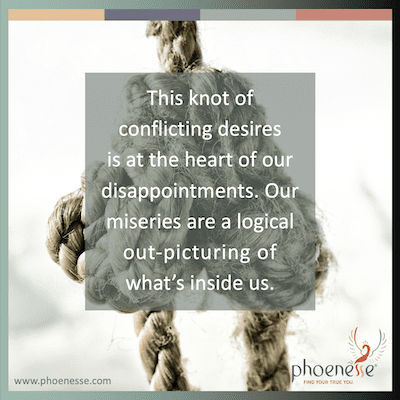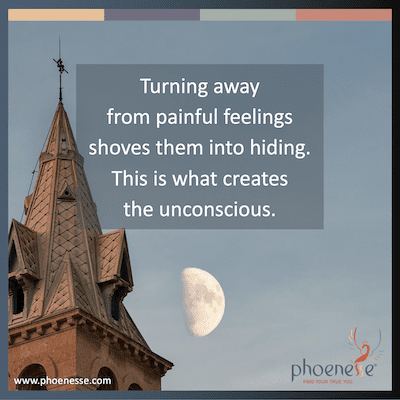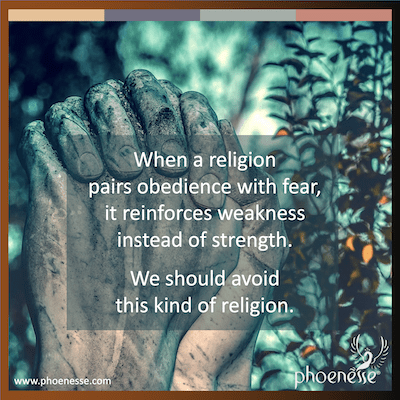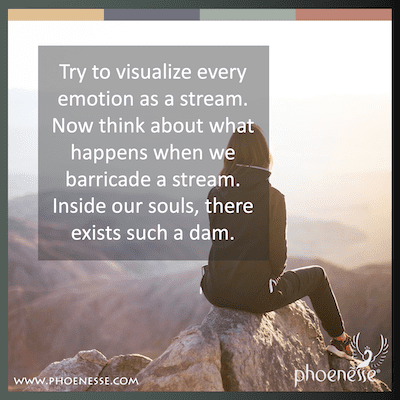
Why mixed motives matter so much
The goal of life—the true purpose for being here—is to get to know yourself. To find your true you. When we do this, we are able to fulfill our deepest desires. But to do that, we must get to know parts of ourselves we have been unaware of so far.
We may not even realize that the human personality has many, many facets. As such, we often don’t really understand what it even means “to know yourself.” Yes, we all know at least a little about ourselves. Like, we know what we consciously want. And we may know about our tastes and our little quirks.
But then there’s all the stuff we completely ignore. Think, for a moment, about how you act with a particular person in your life. Let’s call this person “A”. Now do the same with person “B”. What would happen if you acted the same with person B as you do with A?
You could probably go through the whole alphabet this way, changing people and situations and getting awkward results. In this way, we can start to see just how many facets we have. And that’s just on the surface. Many facets of us never reach the surface.
So then, who are we, really?
What do we desire?
A good place to start is to ask: What do I desire? Of course, we might first think of our biggest aims and goals. But even more important, we want to look at any small and seemingly insignificant daily reaction. For our reactions always contain some kind of desire.
Think about some unimportant incident that left you feeling a certain way. Maybe you were angry or irritated, hurt or frustrated. Or perhaps you had a reaction that was joyful and optimistic. Nestled in each of these reactions was a desire.
The way to find out who we are is to figure out the desire that is embedded in each of our daily reactions. This isn’t that hard to do. It’s also not that easy.
The trick, if you will, is to develop a habit of self-questioning. First, we must articulate a concise awareness of our desires. Then we need to explore the reasons we have them. The process goes something like this:
Step one: Write down, each day, what reactions you noticed. For example, “I felt angry when…”, or “I was hopeful when…”.
Step two: Ask yourself why you felt these reactions. No matter how obvious the reason may at first seem, dig a little deeper.
Step three: Search for the desire behind each reaction. “What do a I really want from this situation, which currently makes me fearful, hurt or angry?” If you want something different, what is it you want?
Maybe your reaction is, “I am happy because my desire was met.” What was the desire? Or “I felt hopeful because the chances are looking better…” to fulfill what desire? Try to use simple, clear-cut words to describe the desire.
Doing this process daily is an excellent way to understand ourselves better. It will also help us to understand why we have certain desires.
In other words, how did we become who we are today?
Moving in the right direction
Until now, we’ve been talking about our conscious desires. But these aren’t the only kind of desire we have. For we also have unconscious desires. And these desires often oppose our conscious ones.
This, friends, is one of the main reasons we find ourselves frustrated and mired in conflict. Worse yet, we fail to see how we are the ones creating our frustrations and conflicts.
Here’s the real crux of the problem: We have certain conscious desires that guide our actions. And these typically align nicely with the aims of our Higher Self. At the same time, we have selfish aims that are mixed in with our positive motivation.
But because we manage to justify our lower aims—to ourselves and to others—our Lower Self motivations hide themselves in our higher aims. As such, we can’t see how we are creating our own problems.
Let’s say our actions are worthy and our motives for some noble goal are good, as far as that goes. But we overlook the fact that we also have less admirable motives—selfish, proud, vain and fearful motives. And these share the very same goal.
Just seeing this is a step in the right direction.
Here’s a practical example:
Let’s say we have a desire for fulfillment through a chosen career. We want to perform well and be well-compensated for our talents and efforts. At the same time, we want the advantages of the opposite desire, which is to not have to apply ourselves. This latter motive—the desire to be taken care of and to not have to work very hard—might not sound very flattering. That’s why we repress this motive and lock it away.
But the more unconscious an emotion or desire is, the more effect it has in our life. Consequently, we get exactly what we consciously don’t desire, but in fact, unconsciously want. Bear in mind that in our Lower Self, we do have this desire. Further, we want it without any strings attached, without any downsides.
Then we stand back, miserable and outraged that life keeps doing this to us!
What happens is that our conscious noble motive convinces us there is nothing wrong with our goal. Meanwhile, we completely ignore that there is, in fact, something wrong. Namely, we don’t realize that this other part exists, and it’s moving in the same current of desire.
We like to believe that we’re made up of one exclusive attitude. That the truth of one good motive wipes out the truth of another less good—if not completely contrary—motive.
But one does not exclude the other. They both matter.
The way to change
This path of self-development is sometimes called a path of self-purification. Purification, however, does not mean we just cast out wrong desires. It means we separate out the good from the bad and then transform whatever is flowing the wrong way.
At first, we just become aware of these countercurrents. The next step, though, will never be to force our feelings to change. It may be tempting to try, but this cannot be done. Emotions simply don’t work that way.
What can be done is to sort out our desires. We can say something like this to ourselves: “Here is this desire, which is good. I also see that I have a selfish motive playing a role. I’ll keep doing the best I can, but I am going to stop kidding myself that I am not being selfish here. I pray to keep seeing these unruly currents, hoping they will weaken with time. I can’t change how I feel right now, but I believe I can free myself of these hidden currents.”
If we keep at it, over time, these misaligned currents will indeed weaken. Eventually, they will disappear altogether. And this will go a long, long way toward purifying us. Far more than any attempt to force our feelings to change.
What happens too often is that we are, in some way, aware of our selfish motives. What do we do then? We cover them up. The result: This gives them even more power. For now they operate completely unchecked.
When we pretend they don’t exist, we wrongly believe they are all gone. That we are squeaky clean and pure. That our motives are all good.
Meanwhile, rotten motives are fermenting in our unconscious.
Where the power lies
We tend to make a definite distinction between thoughts and feelings. But from the Spirit World’s perspective, these are essentially the same. The only difference is their strength and intensity.
A feeling is always more potent than any thought we might have. As such, any opinion or conviction we harbor that is fortified by our emotions will be stronger. This works the same for views built on truth as it does for those built on untruth. That’s why it’s so hard to change any opinion—whether right or wrong, good or bad, helpful or unhelpful—that’s emotionally charged.
But no matter how strong a conscious thought may be, it’s no match for the strength of an emotional current that is utterly unconscious. This is an important reality we are sure to discover when we embark on this spiritual path.
Our work, as we develop, will be to bring our emotions into our conscious awareness. Once we clarify them and understand them, we can decide whether we want to act on them. When we do this, we start living in a higher degree of consciousness than when we act and don’t understand why.
For we tend to behave badly when we are controlled by our unconscious feelings and thoughts. Although we might be very good at justifying our behavior.
Change is hard
Humans are incredibly bound by habit. It’s hard enough to change our minds about anything, but it takes far longer to change an emotion. For example, say we’ve held a certain opinion our whole life. Maybe it’s not even that important to us. But our surroundings have encouraged us to hold on to it. It’s never occurred to us to change it, even though it’s been obsolete a long time.
How much harder, then, will it be to change an attitude when we have a personal stake. Like when our emotions are involved. There is a huge temptation to stay to stuck. It requires a tremendous fight to overcome this sluggishness and swallow our pride. Indeed, it also takes a certain amount of humility to give up views we’ve held a long time.
Even when we know, deep in our hearts, that it’s time for a new outlook, we will cling to an old opinion. Often, we’ll do this simply because we’ve had it quite a while.
So, if changing even our most surface opinions takes a bit of effort and humility, consider how much more patience and wisdom will be necessary to change an outlook where we have deep-rooted feelings.
Our images color everything
When we look at our problems and conflicts through the lens of our desires, we will also see how our images were formed. Images, according to the Pathwork Guide, are the wrong conclusions we form about life at a young age. Images are highly charged and they go on to warp our entire perception of reality. To uncover them, we must work from two sides.
First, we must look at our childhood and examine the reactions we had back then. Second, we must explore our present-day emotional reactions—those highly charged reactions that upset us—and discover the mix of desires behind them. With all this uncovered, we will start to see the whole picture of our life.
When we search for our desires this way, we’ll start to understand why some of them are stronger than others. We’ll see why some are broken by countercurrents, while others flow rigidly in one direction. They are all comprised of the many layers of our personality. And they all hold mixed motives.
When we unearth our good as well as bad motives, it will become clear why we thought we needed to hide the bad ones.
Untangling inner knots
Know, too, that while our life may outwardly appear to be running well, inside, we might be in turmoil. There is often so much confusion in our souls. That is what happens when we suppress unwanted desires that conflict with our conscious desires. Then everything becomes a tangled knot.
And it is painstaking work to unravel all these inner knots.
It may frighten us to realize that we don’t know what we want. As a result, we may try to escape into some desire we believe will keep us safe. Like, I just want to be loved all the time, by everyone. Or, I just want to be in control of everything and everyone. Or, I just want to be left alone, rising above it all. The Pathwork Guide calls these pseudo-solutions, or defenses.
To sort out our legitimate desires from our destructive defenses, we’ll need to pick out each of the strings of our inner knots, one by one. We must pull them apart and trace them to their origins. Because each little string represents a little desire. Each one has a motive behind it. And unconsciously, we believe we can’t afford to see the full array of our many mixed motives.
After all, we think, I’m a smart person and I am highly developed in many respects. So then how can I admit that this jumble of contradictory desires is going on inside me? That my hidden and conscious motives are cancelling each other out?
But this is what goes on in the fractured, immature parts of our Lower Self. There is literally a young, wounded, split-off aspect inside us that desires two impossible things, maybe more. We think that as long as we hide this conflict, we get rid of it.
The truth is, this complicated knot is sitting in the middle of all our disappointments and disharmonies in life.
It’s up to us to untangle it.
Inner conflicts lead to outer unfulfillment
The only way out is to pick up each and every string—to take each daily emotional reaction—and then have the patience and courage to find the desire in it. At first, we just want to notice the desire. Don’t judge or evaluate it saying, “this is silly, that’s impossible, this is beneath me.” Such an approach will only make it harder to untie the knot.
Keep in mind that our hidden emotions are not linked with our outer common sense. There is, however, a logic to how this all operates. In short, our desires, feelings and thoughts—conscious and unconscious, but especially unconscious—are powerful magnetic fields. That means they attract circumstances to us that match our inner conflicts.
So our conflicting desires are at the heart of our unfulfillments in life. Our miseries are a logical out-picturing of what’s inside us.
That’s why it is so important to get to know ourselves.
Behaving better towards others
It is natural, when we walk this path—when we do the work of spiritual healing—that many of our hidden emotions will come to the surface. And the more conscious they become, the more likely we are to be considerate of others. For as long as we are controlled by what we’ve hidden in our unconscious, we can’t help but be unpleasant to the people around us.
We may not even be aware we are doing this. For we fail to observe our own behavior, the same way we’re blind to the parts of our psyche we wish to avoid.
When we decide to explore ourselves, however, we are obligated to also consider the effect we have on others. Our work is to see ourselves more clearly, including our hidden difficult emotions, but not to take them out on others.
The more we grow in self-awareness, the more unselfish we must become. We will then naturally become more conscious of how we behave, and therefore of how we affect our surroundings.
This process of self-development will lead us to see through our confusions. By doing this, we can have one clear desire going steadfastly in one direction. What’s more, this process will mature parts of us enough to realize there’s a price we must pay to have what we want.
Gradually, we’ll come to see that with faith and perseverance, it is possible to have what we truly desire.
That is the way of this path.
– The Guide’s wisdom in Jill Loree’s words

Adapted from Pathwork Guide Lecture #45: The Conflict Between Conscious and Unconscious Desires




